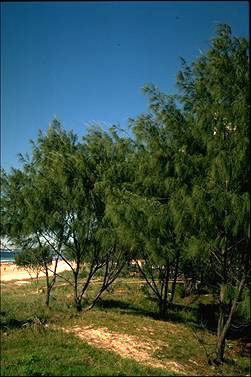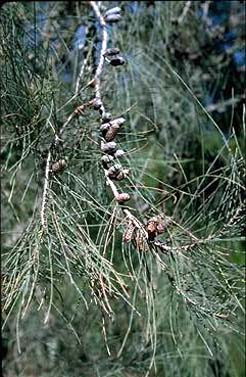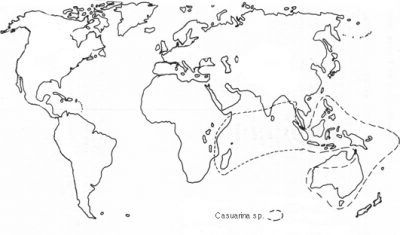

Casuarina equisetifolia L. in Australia (photo by Greig, D. used with permission from the Australian National Botanic Gardens)
Allocasuarina distyla in Australia (photo by Greig, D. used with permission from the Australian National Botanic Gardens)
Casuarinaceae species |
||
| Allocasuarina sp C. cunninghamiana Miq. (river sheoak) C. equisetifolia L. (beach sheoak) |
C. glauca Sieb. ex. Spreng. (gray sheoak) C. cristata F. Muell. (belah) |
Gymnostoma australianum (Daintree Pine) Ceuthostoma |
(Ecology of the Casuarinaceae symbioses)
The Casuarinaceae has four genera and about 96 species: Gymnostoma L. Johnson (18 species; one in northeastern Queensland, the rest in Malesia, the Solomons, Fiji and New Caledonia), Ceuthostoma L. Johnson (two species in Malesia, from Palawan and Borneo to New Guinea), Casuarina L. (17 species; six in Australia, others from the Bay of Bengal to Polynesia) and Allocasuarina L. Johnson (58 species in Australia). All grow in tropical climates. Casuarina sp. is found in warm temperate regions and Allocasuarina is mainly in warm to the southern cool temperate regions of Australia.
The Casuarinaaceae has been placed phylogenetically in the Fagales (APG, 1998; Chase, et al., 1993). All members ot the family have slender, wiry branches and reduced leaves. Members have been transplanted widely on islands and coastal regions of the Indian Ocean, Africa and the Americas. Molecular phylogenies place Gymnostoma L.A.S. Johnson sister to the rest of the family and Allocasuarina L.A.S. Johnson as the most derived (Maggia and Bousquet, 1994; Sogo et al., 2001).

Fossil evidence for the family dates to the Eocene (55-39 mybp). Macrofossils of Gymnostoma and Ceuthostoma L.A.S. Johnson have been discovered in New Zealand and South America which is outside of their present range. The absence of both macrofossils and undisputed fossil pollen in the northern hemisphere has led most researchers to assume that the family had its origins in Gondwanaland (Johnson and Wilson, 1989).
Members of all four genera nodulate, albeit by a different collection of Frankia strains. Gymnostoma spp. are nodulated by Cluster 3 Frankia strains, while more derived members of the family, Casuarina L. and Allocasuarina, interact with a restricted set of strains from Cluster 1 . This observation has led to the hypothesis the family is evolving towards strain specificity (Maggia and Bousquet, 1994). Alternatively, the specificity of Casuarina and Allocasuarina is simply due to the drier habitats of Australia that these genera inhabit, where a smaller subset of Frankia strains are able to survive.
For a discussion of the ecological associations between casuarinas and Frankia go to the the Casuarina Frankia page. For a discussion of the evolutionary relationships between plant and Frankia go to the Frankia Phylogeny and Plant Phylogeny pages. Images and botanical information on species within the Casuarinaceae can be found at the Australian Plant Image Index at the Australian National Botanic Garden.